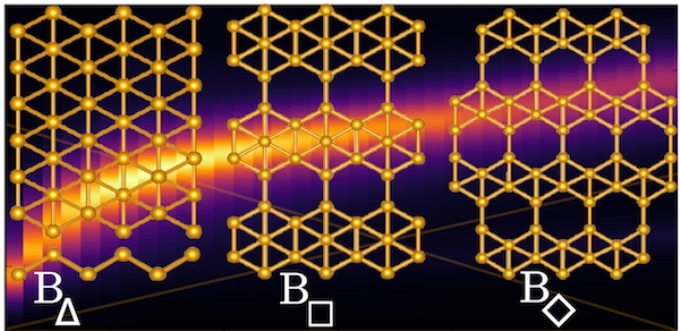Nov 21 2017
According to Rice University researchers, an atom-thick film of boron could be the first pure 2D material that is capable of discharging visible and near-infrared light by triggering its plasmons.
 Rice University scientists calculate that the atom-thick film of boron known as borophene could be the first pure two-dimensional material naturally able to emit visible and near-infrared light by activating its plasmons. The Rice team tested models of three polymorphs and found that triangular borophene, at left, was capable of emitting visible light, while the other two reached near-infrared. Illustration by Sharmila Shirodkar
Rice University scientists calculate that the atom-thick film of boron known as borophene could be the first pure two-dimensional material naturally able to emit visible and near-infrared light by activating its plasmons. The Rice team tested models of three polymorphs and found that triangular borophene, at left, was capable of emitting visible light, while the other two reached near-infrared. Illustration by Sharmila Shirodkar
That would make the material referred to as borophene a contender for photonic and plasmonic devices like waveguides, nanoscale light harvesters, biomolecule sensors, and nanoantennas.
Plasmons are collective excitations of electrons that flow across the surface of metals when stimulated by an input of energy, like laser light. Significantly, providing light to a plasmonic material in one color (established by the light’s frequency) can prompt the release of light in another color.
Models by Rice theoretical physicist Boris Yakobson and his colleagues envisage that borophene would be the first known 2D material to do so naturally, without alteration.
The lab’s models are described in a paper in the Journal of the American Chemical Society by Yakobson with lead authors Yuefei Huang, a graduate student, and Sharmila Shirodkar, a postdoctoral researcher.
In three dimensions, boron is a semiconductor but in 2D form it is a metal. That provoked the lab to take a look at its potential for plasmonic manipulation.
“This was kind of anticipated, but we had to do careful work to prove and quantify it,” said Yakobson, whose lab frequently predicts potential materials that experimentalists later make, like the boron buckyball or borophene. With colleagues Evgeni Penev, an assistant research professor at Rice, and alumnus Zhuhua Zhang, he lately published a wide-ranging review of the state of boron research.
In the latest study, the team used a computational modeling method known as density functional theory to analyze plasmonic behavior in three types of free-standing borophene. The baseline crystal structure of the material is a grid of triangles — think graphene but with an additional atom in the center of each hexagon.
The lab analyzed models of plain borophene and two polymorphs, solids that integrate more than one crystalline structure that are created when a few of those middle atoms are removed. Their calculations revealed triangular borophene had the broadest emission frequencies, including visible light, while the other two touched near-infrared.
We don’t have enough experimental data to determine which mechanisms contribute how much to the losses in these polymorphs, but we anticipate and include scattering of plasmons against defects and excitation of electrons and holes that lead to their damping.
Sharmila Shirodkar, a postdoctoral researcher
The researchers said their results present the stimulating possibility of controlling data at subdiffraction wavelengths.
“If you have an optical signal with a wavelength that’s larger than an electronic circuit of a few nanometers, there’s a mismatch,” she said. “Now we can use the signal to excite plasmons in the material that pack the same information (carried by the light) into a much smaller space. It gives us a way to squeeze the signal so that it can go into the electronic circuit.”
It turns out that’s important because, roughly speaking, it can improve the resolution by 100 times, in some cases, resolution is limited by wavelength. By using plasmons, you can store information or write into a material at a much higher resolution because of the shrinkage of the wavelength. This could have great benefits for data storage.
Boris Yakobson, Rice theoretical physicist
Experimentalists have created borophene only in very tiny quantities thus far and lack techniques to transfer the material from the surfaces on which it is grown, Yakobson said. Still, there is plenty for theoretical scientists to examine and ample progress in the labs.
“One should explore other polymorphs and look for the best one,” Yakobson suggested. “Here, we didn’t. We just considered three, because it’s pretty heavy work — but others need to be screened before we know what is achievable.”
The research was supported by the Army Research Office and the Robert Welch Foundation. Computational resources were supplied by Rice’s National Science Foundation-supported DAVinCI supercomputer administered by Rice’s Center for Research Computing and procured in collaboration with Rice’s Ken Kennedy Institute for Information Technology.
Yakobson is a professor of chemistry and the Karl F. Hasselmann Professor of Materials Science and NanoEngineering.